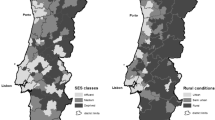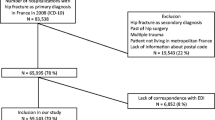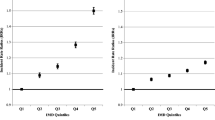Abstract
Summary
In this prospective, 10-year study in community-dwelling elderly aged 50 years and over, hip fracture incidence and accordingly age at hip fracture were inversely associated with the area-level income, independently of the geographical area. Age at hip fracture also depended of marital status but in a gender-specific way.
Purpose
The purpose of this study is to investigate the impact of socioeconomic and living conditions on hip fracture incidence and age occurrence among community-dwelling elderly.
Method
Between January 1991 and December 2000, 2,454 hip fractures were recorded in community-dwelling adults aged 50 years and over in the Geneva University Hospital, State of Geneva, Switzerland. Median annual household income by postal code of residence (referred to as area-level income) based on the 1990 Census was used as a measure of socioeconomic condition and was stratified into tertiles (<53,170; 53,170–58,678; and ≥58,678 CHF). Hip fracture incidence and age occurrence were calculated according to area-level income categories and adjusted for confounding factors among community-dwelling elderly.
Results
Independently of the geographical area (urban versus rural), community-dwelling persons residing in areas with the medium income category presented a lower hip fracture incidence [OR 0.91 (0.82–0.99), p = 0.049] compared to those from the lowest income category. Those in the highest income category had a hip fracture at a significant older age [+1.58 (0.55–2.61) year, p = 0.003] as compared to those in the lowest income category. Age at hip fracture also depended on marital status but in a gender-specific way, with married women fracturing earlier.
Conclusions
These results indicate that incidence and age occurrence of hip fracture are influenced by area-level income and living conditions among community-dwelling elderly. Prevention programs may be encouraged in priority in communities with low income.
Similar content being viewed by others
References
Keene G, Parker M, Pryor G (1993) Mortality and morbidity after hip fractures. BMJ 307:1248–1250
Schürch MA, Rizzoli R, Mermillod B, Vasey H, Michel JP, Bonjour JP (1996) A prospective study on socioeconomic aspects of fracture of the proximal femur. J Bone Miner Res 11:1935–1942
Guilley E, Lalive d'Epinay C (2008) Social status and mortality with ADL-disability in later life. J Gerontol B Psychol Sci Soc Sci 63:192–196
Kawachi I, Marshall S, Pearce N (1991) Social class inequalities in the decline of coronary heart disease among New Zealand men, 1975–1977 to 1985–1987. Int J Epidemiol 20:393–398
Mackenbach JP, Kunst AE, Cavelaars AE, Groenhof F, Geurts JJ (1997) Socioeconomic inequalities in morbidity and mortality in western Europe. The EU working group on socioeconomic inequalities in health. Lancet 349:1655–1659
Marmot MG (1984) Inequalities in death—specific explanations of a general pattern? Lancet 1:1003–1006
Pickett KE, Pearl M (2001) Multilevel analyses of neighbourhood socioeconomic context and health outcomes: a critical review. J Epidemiol Community Health 55:111–122
Farahmand BY, Persson P-G, Michaëlsson K, Baron JA, Parker MG, Ljunghall S (2000) Socioeconomic status, marital status and hip fracture risk: a population-based case-control study. Osteoporos Int 11:803–808
Vestergaard P, Rejnmark L, Mosekilde L (2006) Socioeconomic aspects of fractures within universal public healthcare: a nationwide case-control study from Denmark. Scand J Public Health 34:371–377
Wilson RT, Chase GA, Chrischilles EA, Wallace RB (2006) Hip fracture risk among community-dwelling elderly people in the United States: a prospective study of physical, cognitive, and socioeconomic indicators. Am J Public Health 96:1210–1218
Brennan SL, Pasco JA, Urquhart DM, Oldenburg B, Hanna F, Wluka AE (2009) The association between socioeconomic status and osteoporotic fracture in population-based adults: a systematic review. Osteoporos Int 20:1487–1497
Bacon WE, Hadden WC (2000) Occurrence of hip fractures and socioeconomic position. J Aging Health 12:193–203
Jones S, Johansen A, Brennan J, Butler J, Lyons RA (2004) The effect of socioeconomic deprivation on fracture incidence in the United Kingdom. Osteoporos Int 15:520–524
Reimers A, Laflamme L (2007) Hip fractures among the elderly: personal and contextual social factors that matter. J Trauma 62:365–369
Zingmond DS, Melton LJ, Silverman SL (2004) Increasing hip fracture incidence in California Hispanics, 1983 to 2000. Osteoporos Int 15:603–610
Icks A, Haastert B, Wildner M, Becker C, Rapp K, Dragano N, Meyer G, Rosenbauer J (2009) Hip fractures and area level socioeconomic conditions: a population-based study. BMC Public Health 9:doi:10.1186/1471-2458-1189-1114
West J, Hippisley-Cox J, Coupland CAC, Price GM, Groom LM, Kendrick D, Webber E (2004) Do rates of hospital admission for falls and hip fracture in elderly people vary by socio-economic status? Public Health 118:576–581
Brennan nee Saunders J, Johansen A, Butler J, Stone M, Richmond P, Jones S, Lyons R (2003) Place of residence and risk of fracture in older people: a population-based study of over 65-year-olds in Cardiff. Osteoporos Int 14:515–519
Butler M, Norton R, Lee-Joe, Cheng A, Campbell AJ (1996) The risks of hip fracture in older people from private homes and institutions. Age Ageing 25:381–385
Guilley E (2005) La vie en institution. In: Wanner P, Sauvain-Dugerdil C, Guilley E, Hussy C (eds) Ages et Générations; La vie après 50 ans en Suisse; analyse générale du recensement de la population 2000. Office Fédéral de la Statistique, Neuchâtel
Larsson S, Eliasson P, Hansson LI (1989) Hip fractures in northern Sweden 1973–1984. A comparison of rural and urban populations. Acta Orthop Scand 60:567–571
Sernbo I, Johnell O, Andersson T (1988) Differences in the incidence of hip fracture; comparison of an urban and a rural population in southern Sweden. Acta Orthop Scand 59:382–385
Chevalley T, Herrmann F, Delmi M, Stern R, Hoffmeyer P, Rapin C-H, Rizzoli R (2002) Evaluation of the age-adjusted incidence of hip fractures between urban and rural areas: the difference is not related to the prevalence of institutions for the elderly. Osteoporos Int 13:113–118
Espino DV, Palmer RF, Miles TP, Mouton CP, Wood RC, Bayne NS, Markides KP (2000) Prevalence, incidence, and risk factors associated with hip fractures in community-dwelling older Mexican Americans: results of the Hispanic EPESE study. Establish population for the epidemiologic study for the elderly. J Am Geriatr Soc 48:1252–1260
Hökby A, Reimers A, Laflamme L (2003) Hip fractures among older people: do marital status and type of residence matter? Public Health 117:196–201
Korpelainen R, Korpelainen J, Heikkinen J, Väänänen K, Keinänen-Kiukaanniemi S (2006) Lifelong risk factors for osteoporosis and fractures in elderly women with low body mass index—a population-based study. Bone 39:385–391
Peel NM, McClure RJ, Hendrikz JK (2007) Psychosocial factors associated with fall-related hip fractures. Age Ageing 36:145–151
Wolinsky FD, Fitzgerald JF (1994) The risk of hip fracture among noninstitutionalized older adults. J Gerontol B Psychol Sci Soc Sci 49:165–175
Young Y, Myers AH, Provenzano G (2001) Factors associated with time to first hip fracture. J Aging Health 13:511–526
Chevalley T, Guilley E, Herrmann F, Hoffmeyer P, Rapin C-H, Rizzoli R (2007) Incidence of hip fracture over a 10-year period (1991–2000): reversal of a secular trend. Bone 40:1284–1289
Guilley E, Chevalley T, Herrmann F, Baccino D, Hoffmeyer P, Rapin CH, Rizzoli R (2008) Reversal of the hip fracture secular trend is related to a decrease in the incidence in institution-dwelling elderly women. Osteoporos Int 19:1741–1747
Guilley E, Lalive d'Epinay C (2008) The closing chapters of long lives: results from the 10-year Swilsoo study on the oldest old. Nova Science Publishers, Hauppauge NY
Ribbe MW, Ljunggren G, Steel K, Topinková E, Hawes C, Ikegami N, Henrard JC, Jónnson PV (1997) Nursing homes in 10 nations: a comparison between countries and settings. Age Ageing 26:3–12
Laaksonen M, Talala K, Martelin T, Rahkonen O, Roos E, Helakorpi S, Laatikainen T, Prattala R (2008) Health behaviours as explanations for educational level differences in cardiovascular and all-cause mortality: a follow-up of 60 000 men and women over 23 years. Eur J Public Health 18:38–43
Lee SJ, Sudore RL, Williams BA, Lindquist K, Chen HL, Covinsky KE (2009) Functional limitations, socioeconomic status, and all-cause mortality in moderate alcohol drinkers. J Am Geriatr Soc 57:955–962
Markides KS, Black SA (1995) Race, ethnicity, and aging: the impact of inequality. In: Binstock RH, Georges LK (eds) Handbook of aging and the social sciences. Academic, San Diego, pp 153–170
Cooper C, Westlake S, Harvey N, Javaid K, Dennison E, Hanson M (2006) Review: developmental origins of osteoporotic fracture. Osteoporos Int 17:337–347
Schiller JS, Adams PF, Coriaty Nelson Z (2005) Summary health statistics for the US population: National Health Interview Survey, 2003. Vital Health Stat 10:29
Neuner JM, Zhang X, Sparapani R, Laud PW, Nattinger AB (2007) Racial and socioeconomic disparities in bone density testing before and after hip fracture. J Gen Intern Med 22:1239–1245
Rapiti E, Fioretta G, Schaffar R, Neyroud-Caspar I, Verkooijen HM, Schmidlin F, Miralbell R, Zanetti R, Bouchardy C (2009) Impact of socioeconomic status on prostate cancer diagnosis, treatment, and prognosis. Cancer. doi:10.1002/cncr.24607
Brennan SL, Henry MJ, Wluka AE, Nicholson GC, Kotowicz MA, Williams JW, Pasco JA (2009) BMD in population-based adult women is associated with socioeconomic status. J Bone Miner Res 24:809–815
Davidson LL, Durkin MS, Kuhn L, O'Connor P, Barlow B, Heagarty MC (1994) The impact of the safe kids/healthy neighborhoods injury prevention program in Harlem, 1988 through 1991. Am J Public Health 84:580–586
Schwarz DF, Grisso JA, Miles C, Holmes JH, Sutton RL (1993) An injury prevention program in an urban African-American community. Am J Public Health 83:675–680
Guilley E, Pin S, Spini D, Lalive d'Epinay C, Herrmann F, Michel JP (2005) Association between social relationships and survival of Swiss octogenarians; a five-year prospective, population-based study. Aging Clin Exp Res 17:419–425
Wallsten SS (2000) Effects of care giving, gender, and race on the health, mutuality, and social supports of older couples. J Aging Health 12:90–111
Acknowledgments
We thank René Bourdilloud (University Hospital of Geneva) for extracting the data file from the hospital information system and Daniel Baccino (Center for Interdisciplinary Gerontology) for data management. We acknowledge the assistance of Sophie Mouchet, Janine Dubois, and Chiara D'Aiuto from the local State Statistical Office, for providing us with official population data and data on population in nursing homes.
Conflict of interest
None
Author information
Authors and Affiliations
Corresponding author
Additional information
This work is dedicated to Charles-Henri Rapin’s memory.
Rights and permissions
About this article
Cite this article
Guilley, E., Herrmann, F., Rapin, CH. et al. Socioeconomic and living conditions are determinants of hip fracture incidence and age occurrence among community-dwelling elderly. Osteoporos Int 22, 647–653 (2011). https://doi.org/10.1007/s00198-010-1287-1
Received:
Accepted:
Published:
Issue Date:
DOI: https://doi.org/10.1007/s00198-010-1287-1




